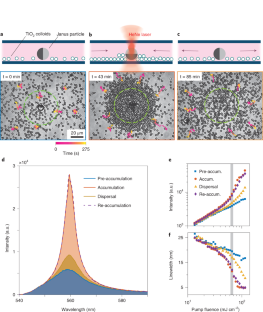2022-07-27 アメリカ合衆国・マサチューセッツ工科大学(MIT)

・ MIT が、バット光重合 3D プリンティング技術によるプラズマセンサー(逆電位アナライザー: RPAs)の作製を初めて実証。
・ 高コストで複雑なクリーンルームで製造される最先端の半導体プラズマセンサーに匹敵する性能を備え、数十ドルのコストと数日間で 3D プリント作製できるため、地球の上層大気では通信・環境モニタリングや、低出力で軽量の安価な人工衛星である CubeSats での利用に理想的。
・ シリコン等の従来センサー材料に比べて高耐久性のガラス-セラミック材料であるヴィトロライトを使用し、地球低軌道の極端な温度差を耐える複雑な形状の RPAs を作製した。20 世紀初頭に開発されたヴィトライトは、アール・デコ建築物の多彩なタイルで使用され、800℃までの温度を耐久する(半導体 RPAs のポリマーは 400℃で溶解)。
・ RPAs は 1959 年の宇宙探査ミッションで初めて採用されたセンサーで、プラズマ(地球高層大気中の超活性化した分子の混合状態)中のイオンエネルギーを検出する。CubeSats のような小型人工衛星に搭載し、天候予測や気候変動のモニタリングに役立つエネルギー測定や化学分析が実施できる。
・ セラミック粉をレーザーの高熱で溶解して形成する 3D プリンティング技術では、材料の粗さが残ったり、脆弱な箇所が発生したりする。本研究では、ポリマーや樹脂材料を対象に数十年前に開発されたバット重合技術を採用。同技術では、僅か 100 ミクロンの薄さの層の滑らかで孔のない複雑なセラミック構造を形成できる。
・ 広範囲のプラズマ捕獲・測定や(超高精度半導体デバイスでのみ可能な)高密度・低温度プラズマ測定を含む 4 種類のプロトタイプを設計。核融合エネルギー研究や超音速フライトのアプリケーションも可能。高速プロトタイピングプロセスのため、人工衛星やスペースクラフト設計のイノベーションを引き起こす可能性もある。
・ 今後は製造プロセスの向上を図る。積層の薄さやピクセルサイズをさらに低減することで、より精密なハードウェアが作製できる。また、3D プリンティングで完全にセンサーが作製できれば、宇宙でのオンサイト製造も可能に。重量を大幅に低減しながら構造的な強度を保持するような、特定の用途に向けたセンサーの AI の活用による最適化についても検討する。
・ 本研究は、MIT、MIT-Tecnologico de Monterrey Nanotechnology プログラム、MIT Portugal プログラムおよびポルトガル科学技術財団(FCT)が支援した。
URL: https://news.mit.edu/2022/rpa-sensors-satellites-3d-print-0727
<NEDO海外技術情報より>
関連情報
Additive Manufacturing 掲載論文(フルテキスト)
Compact Retarding Potential Analyzers Enabled by Glass-Ceramic Vat Polymerization for CubeSat
and Laboratory Plasma Diagnostics
URL: https://www.sciencedirect.com/science/article/pii/S2214860422004262?via%3Dihub
Highlights
- •Study reports the first plasma sensors enabled by glass-ceramic 3D printing.
- •Four sensor designs for probing ionospheric and laboratory plasmas were developed.
- •Sensors successfully characterized plasmas with a Debye length as small as 50 µm.
- •Device performance on par with that of state-of-the-art, Si microfabricated sensors.
Abstract
We report the design, fabrication, and characterization of novel, digitally manufactured, compact retarding potential analyzers (RPAs), i.e., multi-electrode instruments that can be used as in-orbit mass spectrometers and as on-ground/in-orbit ion energy analyzers. Unlike most RPAs reported in the literature, our devices enforce active aperture alignment across the grid stack, maximizing ion transmission. The RPA electrode housing (the most critical component of the RPA, as it precisely positions the electrodes to maximize grid stack transmission while avoiding space charge effects and providing electrical insulation) is additively manufactured in Vitrolite® (a printable glass-ceramic) via vat polymerization, resulting in non-porous, high-temperature compatible, and high-vacuum compatible hardware. Metrology of as-printed (green) VitroliteⓇ parts shows an in-plane, per axis manufacturing accuracy of 60 µm (i.e., the in-plane length of the voxels) and an out-of-plane manufacturing accuracy of 100 µm (i.e., the height of the slices). VitroliteⓇ 3D-printed objects annealed at 900 °C show a ~5 % shrinkage, a slightly larger maximum tensile stress, a similar Young’s modulus, and a larger compression yield stress compared to green samples. Also, the assembly misalignment between the grids and a 3D-printed housing annealed at 900 °C is a twofold larger compared to using a green housing. Annealing 3D-printed VitroliteⓇ at temperatures above 900 °C causes significant distortion of the printed part due to material reflow, which is incompatible with a precision engineering application. Four different RPA designs were synthesized to probe the ionosphere (design with floating grid alignment at the aperture level) and laboratory plasmas (designs with floating grid aperture alignment at the cluster level). Simulations conducted in this study show that the RPA design that enforces floating grid aperture alignment at the aperture level attains the best performance, although RPA designs that implement floating grid aperture alignment at the cluster level are more resilient to grid misalignment. Experimental characterization of the RPAs using an ion source and a helicon plasma source is consistent with expected performance and the literature. Plasmas with a Debye length as small as 50 µm were successfully characterized using the reported sensors, matching the performance of state-of-the-art RPAs manufactured via semiconductor microfabrication.



